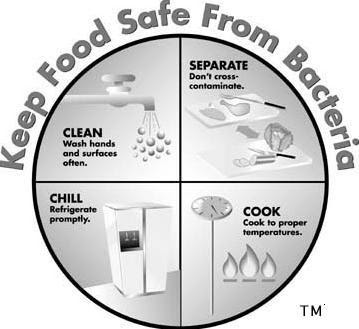A bacterium that occurs widely in nature and is a cause of botulism; it has six main types, A to F. Botulism is a rare but potentially very serious illness. The bacterium may be entered the body through wounds.
A severe, manytimes fatal food poisoning caused by ingestion of food containing botulin. It may be characterized by nausea, vomiting, disturbed vision, muscular weakness, and fatigue.
How is Botulism Transmitted?
Cases of foodborne botulism often come from home-canned foods with low acid content, such as asparagus, green beans, beets, and corn. Clostridium botulinum bacteria is anaerobic, which means it can survive and grow with little or no oxygen. Therefore, it can survive very well in sealed containers. Outbreaks of the botulism are often from more unusual sources such as chili peppers, tomatoes, and improperly handled baked potatoes wrapped in aluminum foil.
Causes
Clostridium botulinum is a spore-forming organism that is common in nature. The spores may be found in soil and certain foods (such as honey and some corn syrups). Infant botulism occurs mostly in young infants between 6 weeks and 6 months of age. It has been reported to occur as early as 6 days and as late as 1 year. Risk factors include swallowing honey as a baby, being around contaminated soil, and having less than one stool per day for a period greater than 2 months.
Symptoms of Botulism
According to the CDC, initial symptoms of Botulism include:
Double vision, slurred speech, difficulty swallowing, and muscle weakness. In the food-borne version, symptoms usually appear within a day or two of consuming the contaminated food.
There are three main types of botulism:
· foodborne botulism
· infant botulism
· wound botulism
Diagnosis
Physicians may consider the diagnosis if the patient's history and physical examination suggest botulism. However, these clues are often not enough to allow a diagnosis of botulism. Other diseases such as Guillain-Barré syndrome, stroke, and myasthenia gravis can appear similar to botulism, and special tests may be needed to exclude these other conditions. These tests may include a brain scan, cerebrospinal fluid examination, nerve conduction test (electromyography, or EMG), and an Edrophonium Chloride (Tensilon) test for myasthenia gravis.
Prevention
Like many germs, the bacteria that cause botulism in infants are everywhere in the environment. They're in dust and dirt. They're even in the air. Experts don't know why some infants end up consuming the airborne bacteria and contracting botulism while others don't.
Treatment
The symptoms of botulism make hospitalization necessary. If diagnosed early, botulism can be treated with an antitoxin, which blocks the action of the toxin circulating in the blood. This can prevent patients from worsening, but recovery still takes many weeks. If left untreated, a patient may need to be on a breathing machine (ventilator) for weeks and would require intensive medical and nursing care. Infant botulism is treated with immune globulin, which is similar to the antitoxin. Most cases of botulism recover with appropriate medical care. The goal of botulism treatment is to establish a clear airway, aid breathing, give botulinus anti-toxin, and provide supportive therapy.
Author: Corwin Brown
A severe, manytimes fatal food poisoning caused by ingestion of food containing botulin. It may be characterized by nausea, vomiting, disturbed vision, muscular weakness, and fatigue.
How is Botulism Transmitted?
Cases of foodborne botulism often come from home-canned foods with low acid content, such as asparagus, green beans, beets, and corn. Clostridium botulinum bacteria is anaerobic, which means it can survive and grow with little or no oxygen. Therefore, it can survive very well in sealed containers. Outbreaks of the botulism are often from more unusual sources such as chili peppers, tomatoes, and improperly handled baked potatoes wrapped in aluminum foil.
Causes
Clostridium botulinum is a spore-forming organism that is common in nature. The spores may be found in soil and certain foods (such as honey and some corn syrups). Infant botulism occurs mostly in young infants between 6 weeks and 6 months of age. It has been reported to occur as early as 6 days and as late as 1 year. Risk factors include swallowing honey as a baby, being around contaminated soil, and having less than one stool per day for a period greater than 2 months.
Symptoms of Botulism
According to the CDC, initial symptoms of Botulism include:
Double vision, slurred speech, difficulty swallowing, and muscle weakness. In the food-borne version, symptoms usually appear within a day or two of consuming the contaminated food.
There are three main types of botulism:
· foodborne botulism
· infant botulism
· wound botulism
Diagnosis
Physicians may consider the diagnosis if the patient's history and physical examination suggest botulism. However, these clues are often not enough to allow a diagnosis of botulism. Other diseases such as Guillain-Barré syndrome, stroke, and myasthenia gravis can appear similar to botulism, and special tests may be needed to exclude these other conditions. These tests may include a brain scan, cerebrospinal fluid examination, nerve conduction test (electromyography, or EMG), and an Edrophonium Chloride (Tensilon) test for myasthenia gravis.
Prevention
Like many germs, the bacteria that cause botulism in infants are everywhere in the environment. They're in dust and dirt. They're even in the air. Experts don't know why some infants end up consuming the airborne bacteria and contracting botulism while others don't.
Treatment
The symptoms of botulism make hospitalization necessary. If diagnosed early, botulism can be treated with an antitoxin, which blocks the action of the toxin circulating in the blood. This can prevent patients from worsening, but recovery still takes many weeks. If left untreated, a patient may need to be on a breathing machine (ventilator) for weeks and would require intensive medical and nursing care. Infant botulism is treated with immune globulin, which is similar to the antitoxin. Most cases of botulism recover with appropriate medical care. The goal of botulism treatment is to establish a clear airway, aid breathing, give botulinus anti-toxin, and provide supportive therapy.
Author: Corwin Brown
